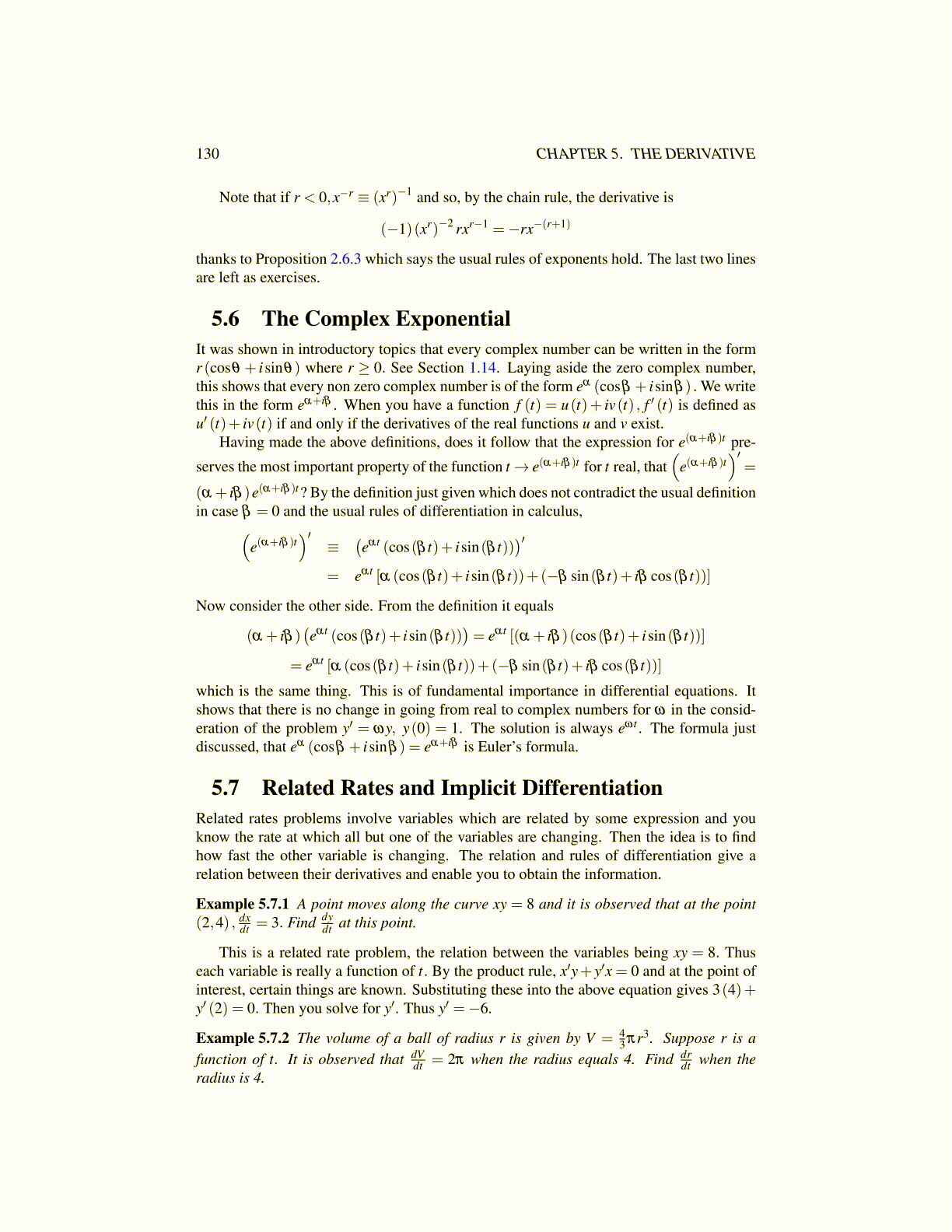
130 CHAPTER 5. THE DERIVATIVE
Note that if r < 0,x−r ≡ (xr)−1 and so, by the chain rule, the derivative is
(−1)(xr)−2 rxr−1 =−rx−(r+1)
thanks to Proposition 2.6.3 which says the usual rules of exponents hold. The last two linesare left as exercises.
5.6 The Complex ExponentialIt was shown in introductory topics that every complex number can be written in the formr (cosθ + isinθ) where r ≥ 0. See Section 1.14. Laying aside the zero complex number,this shows that every non zero complex number is of the form eα (cosβ + isinβ ) . We writethis in the form eα+iβ . When you have a function f (t) = u(t)+ iv(t) , f ′ (t) is defined asu′ (t)+ iv(t) if and only if the derivatives of the real functions u and v exist.
Having made the above definitions, does it follow that the expression for e(α+iβ )t pre-
serves the most important property of the function t → e(α+iβ )t for t real, that(
e(α+iβ )t)′
=
(α + iβ )e(α+iβ )t? By the definition just given which does not contradict the usual definitionin case β = 0 and the usual rules of differentiation in calculus,(
e(α+iβ )t)′
≡(eαt (cos(β t)+ isin(β t))
)′= eαt [α (cos(β t)+ isin(β t))+(−β sin(β t)+ iβ cos(β t))]
Now consider the other side. From the definition it equals
(α + iβ )(eαt (cos(β t)+ isin(β t))
)= eαt [(α + iβ )(cos(β t)+ isin(β t))]
= eαt [α (cos(β t)+ isin(β t))+(−β sin(β t)+ iβ cos(β t))]
which is the same thing. This is of fundamental importance in differential equations. Itshows that there is no change in going from real to complex numbers for ω in the consid-eration of the problem y′ = ωy, y(0) = 1. The solution is always eωt . The formula justdiscussed, that eα (cosβ + isinβ ) = eα+iβ is Euler’s formula.
5.7 Related Rates and Implicit DifferentiationRelated rates problems involve variables which are related by some expression and youknow the rate at which all but one of the variables are changing. Then the idea is to findhow fast the other variable is changing. The relation and rules of differentiation give arelation between their derivatives and enable you to obtain the information.
Example 5.7.1 A point moves along the curve xy = 8 and it is observed that at the point(2,4) , dx
dt = 3. Find dydt at this point.
This is a related rate problem, the relation between the variables being xy = 8. Thuseach variable is really a function of t. By the product rule, x′y+ y′x = 0 and at the point ofinterest, certain things are known. Substituting these into the above equation gives 3(4)+y′ (2) = 0. Then you solve for y′. Thus y′ =−6.
Example 5.7.2 The volume of a ball of radius r is given by V = 43 πr3. Suppose r is a
function of t. It is observed that dVdt = 2π when the radius equals 4. Find dr
dt when theradius is 4.